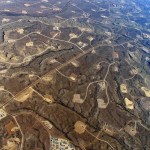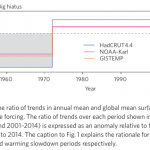greenhouse gas
No joke: California Governor Jerry Brown signed a bill to regulate 'gas' emissions from cows along with other sources of greenhouse gases, of course. According to an interview from NPR, dairy cows are the number one producer of methane in California. The problem with methane is that it is a major component of smog, although according to scientists at the University of California Santa Barbara, it is not the leading cause of global warming. In fact, agriculture-related methane and carbon dioxide emissions are responsible for only 6-7% of greenhouse emissions…
Research makes it increasingly clear that along with drilling for oil and mining coal, extracting natural gas from deep underground causes serious damage to the environment and to public health. On The Pump Handle, Kim Krisberg examines the contamination that may result from dumping fracking wastewater into disposal wells, writing "about 1,000 different chemicals are used in the fracking industry, with more than 100 being known or suspected endocrine disruptors." Researchers collected water samples downstream from wells in West Virginia, and after "exposing both female and male mammalian sex…
A new paper (commentary) on the so-called "pause in global warming" puts it all together.
First let's establish this as a starting point. When climate science contrarians refer to a "pause" or "hiatus" in global warming, they usually mean that the process of warming of the Earth's surface caused by the human release of greenhouse gas is not a thing. They are usually implying, or overtly claiming, that the link between CO2 and other greenhouse gas pollutants and surface warming was never there to begin with, and previous warming, warming before "the pause," was natural variation. Many even…
Do you know the real price of a piece of beef? Here is a nice, round number to chew on: The environmental cost of beef is ten times that of dairy, eggs or poultry. This means that if you chose to eat a steak over an omelet, (assuming they have equal amounts of protein) the ecological footprint of your meal will go from a size 5 to a size 50.
Drs. Ron Milo, Gidon Eshel, research students Alon Shepon and Tamar Makov realized that even though we might try to make the right choices in our diets, we’re likely to base them on the pronouncements of experts. The problem is that neither we nor they…
You may have heard that the release of greenhouse gases has recently gone down, to match levels of several years ago. Why, then, do we have someone saying that greenhouse gasses have reached a new record high?
There are two, maybe three, reasons.
First, even though CO2 release from the US may be lower now than it has been in a few years, it is still high (it was high a few years ago, so we've reduced to a level that is high!). More importantly, the US has reduced its release of CO2 primarily for incidental economic reasons. With a recession/depression going on, there is less money being…
Somewhere around 1990 I wrote an article for a monthly paper on global warming. My intention was to explain the idea behind it (the greenhouse phenomenon) and to make clear the distinction between depletion of the ozone layer and greenhouse effects (the two were getting confused on a regular basis in those days). The reason I mention this is that there was virtually nothing in that article that would not pertain today, and other than the addition of piles and piles of data, there has been almost no change in the science of greenhouse effects that has occurred since then. And by that, I…
Today's guest blogger is Prof. Dan Yakir. Until recently, Yakir was head of the Environmental Sciences and Energy Research Department at the Institute, and he heads the Yatir Forest research station, which monitors, among other things, carbon exchange in a man-made semi-arid pine forest.
This piece comes in the wake of the worst fire in Israel's history, in which extreme drought, winds and a long fire season that depleted fire retardant supplies combined to flame a few embers into a major conflagration that burned thousands of acres of natural scrub forest.Tens of human lives were lost, many…
This is the third (and last) post in our primer of the science of green house gases (see the first two here and here). Our objective is to explain what makes something a greenhouse gas. Why is CO2 a greenhouse gas and not O2 (oxygen) or N2 (nitrogen)? In the first two posts we set the table by explaining electromagnetic (EM) radiation, how we describe it and how it interacts (or doesn't interact) with matter. We pointed out that all physical bodies act like little transmitters of EM radiation and that they can also absorb EM radiation -- but only at the same wavelengths they emit it. Some…
In the first post in this primer series we discussed the nature of electromagnetic radiation. It is via EM radiation that the sun's energy reaches the earth and since it is the balance between the energy that reaches the earth and the energy that is radiated away from the earth that is at the center of the global warming problem, we need to get this part straight. So far we have only talked generally (and very superficially) about what EM radiation is and pointed out that it can carry energy from one point to another (e.g., from the sun to the earth and from the earth back out to surrounding…
Objection to the scientific basis of greenhouse warming seems to be the gift that keeps on giving. That is, if you like getting the same gift over and over again and returning it because it's defective never works. Still, hope springs eternal that understanding something about it will make the disagreements clearer. So this will be the first post about the underlying science. There will be more. It's a primer, so if you know the science it's not for you. But understanding what's under the hood can be explained without requiring agreement on global warming. On the grounds that learning about…
This is just one of dozens of responses to common climate change denial arguments, which can all be found at How to Talk to a Climate Sceptic.
Objection:
In the geological record it is clear that CO2 does not trigger climate changes. Why should it be any different now?
Answer:
Given the fact that the human species and our industrialization is rather unique in the history of planet Earth, do we really need to see some kind of historical precedent for CO2 triggered climate change before accepting what we observe today? Surely unprecedented consequences are not far fetched in the face of…
This is just one of dozens of responses to common climate change denial arguments, which can all be found at How to Talk to a Climate Sceptic.
Objection:
CO2 levels are recorded on top of Mauna Loa...a VOLCANO!! No wonder the levels are so high.
Answer:
Yes, it's true, Mauna Loa is an active volcano. In fact it's the biggest volcano on earth! So, should we suppose that Charles Keeling didn't know that? Well, no, he did know this. And using subtle scientific indicators like "wind direction" he was even able to ensure that his readings were not contaminated by any out gassing when it…
This is just one of dozens of responses to common climate change denial arguments, which can all be found at How to Talk to a Climate Sceptic.
Objection:
Climate scientists never talk about water vapor, which is the strongest greenhouse gas, because it undermines their CO2 theory.
Answer:
There is no climate model or climate textbook that does not discuss the role water vapor plays in the Greenhouse Effect. It is the strongest Greenhouse gas, contributing 36% - 66% to the overall effect for vapor alone, 66% to 85% when you include clouds. It is however, not considered as a climate "forcing…
This is just one of dozens of responses to common climate change denial arguments, which can all be found at How to Talk to a Climate Sceptic.
Objection:
H2O is 95% of the Greenhouse effect, CO2 is insignificant.
Answer:
According to all of the scientific literature and climate experts I am aware of regarding this question, CO2 contributes anywhere from 9 to 30% towards the overall greenhouse effect. Depending on the method you use to determine these percentages they may even add up to more then 100% due to overlap and saturation of the particular frequencies of infra-red radiation each…




